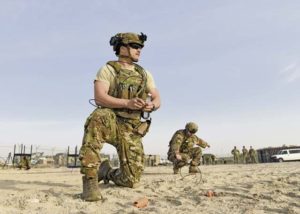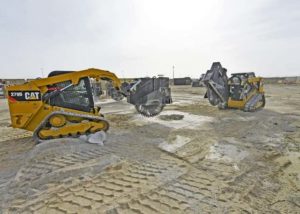ALI AL SALEM AIR BASE, Kuwait — An airfield is one of the most vital aspects of an Air Force installation, enabling Airmen to successfully deliver decisive combat support to the warfighters night and day.
Ensuring the flightline is quickly back to operational status becomes the top priority in the event of a real-world attack.
‘Marauders’ from the 386th Expeditionary Civil Engineer Squadron and Special Purpose Marine Air-Ground Task Force engineers from Ahmed Al Jaber Air Base, Kuwait participated in Rapid Airfield Damage Recovery training at Ali Al Salem Air Base, Kuwait, Feb. 17-19.
The purpose of RADR is for Airmen to become more familiar with the equipment and understand the process, according to 1st Lt. Cody Lokken, 386th ECES Emergency Management Flight commander.

“RADR is a process in which we take an airfield that has sustained an enemy attack, and we get it ready to launch and recover jets again,” said Maj. Brandon Goebel, U.S. Air Forces Central A7 Installations Division Chief.
A mobile training team conducted the RADR training from the 435th Construction and Training Squadron, Ramstein Air Base.
“This is why we have the best RADR program in the world,” said Goebel. “When it comes to what these Airmen can do, going from sustaining an attack to recovering the airfield in just a matter of hours, no one else comes close.”
The training included two days of classroom instruction, which covered the core competencies and procedures followed by hands-on RADR training on the final day, following a simulated attack on the airfield.

RADR involves the majority of civil engineers working together simultaneously to repair the runway expeditiously. Each section throughout the repair is responsible for a certain part of the process.
“First, explosive ordnance disposal will go through and clear the airfield of any unexploded ordnance,” said Goebel. “As they find the UXO’s, they will blow them in place and move on. Later, a sweep will come through to clear any other UXO’s from the airfield.”
After EOD clears the airfield, it is the heavy equipment operator’s responsibility to move debris out of the area. Airmen used heavy construction equipment to break up ‘airfield craters’ into larger holes that are then excavated to a certain depth, and filled in with flowable fill, economical backfill materiel, and rapid set concrete.
“Within just a couple of hours, we can launch aircraft and continue the fight,” Goebel continued. “It’s an example of how resilient our air bases are, and that nothing can stop us. If someone launches an attack on one of our airfields, this process, this program, and most importantly, these engineers, show that we can respond almost immediately to any threat.”
According to Lokken, this training ensures that each engineer shop will have an experienced RADR subject matter expert to facilitate training on a smaller scale throughout the deployment to develop proficiencies.
“This training is a chance for our civil engineer Airmen to showcase their skills and certainly here at [Ali Al Salem], they have proven they are up to the task,” concluded Goebel.


